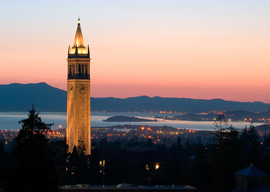
May 05, 2017

Berkeley University, Sather Tower
Source: Bigstock
In December 1964, a Silver Age of American liberalism, to rival the Golden Age of FDR and the New Deal, seemed to be upon us.
Barry Goldwater had been crushed in a 44-state landslide and the GOP reduced to half the size of the Democratic Party, with but 140 seats in the House and 32 in the Senate.
The Supreme Court of Chief Justice Earl Warren, the most liberal in history, was on a roll, and LBJ was virtually unopposed as he went about ramming his Great Society through Congress.
The left had it all. But then they blew it, beginning at Berkeley.
Protests, sit-ins, the holding of cops hostage in patrol cars—went on for weeks to force the University of California, Berkeley, to grant “free speech,” and then “filthy speech” rights everywhere on campus.
Students postured as revolutionaries at the barricades, and the Academic Senate, consisting of all tenured faculty, voted 824-115 to support all Free Speech Movement demands, while cravenly declining to vote to condemn the tactics used.
Middle America saw the students differently—as overprivileged children engaged in a tantrum at the most prestigious school in the finest university system in the freest nation on earth.
Here is how their leader Mario Savio described the prison-like conditions his fellow students had to endure on the Berkeley campus in 1964:
There is a time when the operation of the machine becomes so odious, makes you so sick at heart, that you can’t take part; you can’t even passively take part, and you’ve got to put your bodies upon the gears and upon the wheels, upon the levers, upon all the apparatus, and you’ve got to make it stop. And you’ve got to indicate to the people who run it, to the people who own it, that unless you’re free, the machine will be prevented from working at all!
To borrow from Oscar Wilde, it takes a heart of stone to read Mario’s wailing—without laughing.
As I wondered in an editorial in the St. Louis Globe-Democrat that week, “If there is so much restriction of speech on the campus, how it is that a few yards from Sproul Hall there is a Young Socialist League poster complaining of ‘American Aggression in the Congo’ and calling on students to support ‘the Congolese rebels.’”
Yet Berkeley proved a godsend to a dispirited right.
In 1966, Ronald Reagan would beat Berkeley like a drum in his run for governor, calling the campus, “a haven for communist sympathizers, protesters and sex deviants.”
Reagan relished entertaining his populist following by mocking San Francisco Democrats. “A hippie,” said the Gipper, “looks like Tarzan, walks like Jane and smells like Cheetah.”
More seriously, the radicalism, intolerance, arrogance and fanaticism of the far left in the ‘60s and ‘70s helped to revive the Republican Party and bring it victories in five of the next six presidential elections.
In 1964, neither Nixon nor Reagan appeared to have a bright future. But after Berkeley, both captured the presidency twice. And both benefited mightily from denouncing rioting students, even as liberalism suffered from its perceived association with them.
Which brings us to Berkeley today.
Last week, columnist and best-selling author Ann Coulter was forced to cancel her speech at Berkeley. Her security could not be guaranteed by the university.
In February, a speech of Breitbart editor Milo Yiannopoulos also was canceled out of safety concerns after campus protesters hurled smoke bombs, broke windows and started a bonfire. The decision was made two hours before the event, as a crowd of 1,500 had gathered outside the venue.
The recent attacks on Charles Murray at Middlebury College and Heather Mac Donald at Claremont McKenna call to mind an event from three decades before Berkeley ‘64.